
Elizabeth Township is a township in north central Lancaster County, Pennsylvania, United States. The population was 3,998 at the 2020 census.
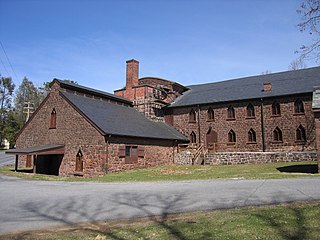
Cornwall is a borough in Lebanon County, Pennsylvania, United States. It is part of the Lebanon, PA Metropolitan Statistical Area. The population was 4,604 at the 2020 census.
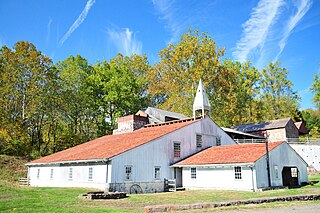
Hopewell Furnace National Historic Site in southeastern Berks County, near Elverson, Pennsylvania, is an example of an American 19th century rural iron plantation, whose operations were based around a charcoal-fired cold-blast iron blast furnace. The significant restored structures include the furnace group (blast furnace, water wheel, blast machinery, cast house and charcoal house), as well as the ironmaster's house, a company store, the blacksmith's shop, a barn and several worker's houses.
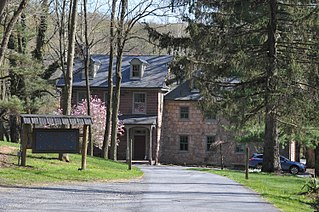
Speedwell Forge Mansion, also known as Speedwell Forge Homestead, is a historic home located at Elizabeth Township, Lancaster County, Pennsylvania. The ironmaster's mansion was built about 1760, and is a 2½-story, four bay wide and two bay deep, brownstone and fieldstone dwelling in the Georgian style. It was expanded about 1795 with a Georgian/Federal style wing. Also on the property are a contributing stone summer kitchen, stone and frame workshop, stone paymaster's office c. 1795), and stone privy.

Iron plantations were rural localities emergent in the late-18th century and predominant in the early-19th century that specialized in the production of pig iron and bar iron from crude iron ore. Such plantations derive their name from two sources: first, because they were nearly self-sufficient communities despite an almost singular focus on the production of iron to be sold on the market, and second, because of the large swaths of forest and land necessary to provide charcoal fuel and ore for their operations. The first plantations stretched across the Northeast, Midwest, and Southern United States, “the chief charcoal iron producing states [being] Pennsylvania, Ohio, New York, Virginia, Connecticut, Maryland, Missouri, Tennessee, and Kentucky." Many produced raw materials used in the American Revolution or to be exported to England. Throughout the remainder of the 19th century, however, only locations that adopted new technologies first introduced by competing coal- and coke-powered smelters in the rapidly industrializing field persisted.

The Horse-Shoe Trail is a 140-mile (230 km) hiking and horseback riding trail in southeastern Pennsylvania, United States. It begins at Valley Forge National Park and ends at a junction with the Appalachian Trail near Harrisburg. Most of the trail is in an agricultural region with gently rolling topography, where it generally follows rural roads and old country lanes, but the western end is much more mountainous and rugged. A 17-mile segment of the trail in Chester and Berks counties has been designated as a National Recreation Trail.
Robert Habersham Coleman was an iron industrialist, railroad president, and owner of extensive farmland in Pennsylvania. He was nationally known as the "Iron King of Pennsylvania." In 1879, he was worth about $7 million. By 1889, he had turned that into $30 million. At the time, he had more money than his contemporaries A. J. Drexel, Marshall Field, J. P. Morgan or Frederick William Vanderbilt.

Cornwall Iron Furnace is a designated National Historic Landmark that is administered by the Pennsylvania Historical and Museum Commission in Cornwall, Lebanon County, Pennsylvania in the United States. The furnace was a leading Pennsylvania iron producer from 1742 until it was shut down in 1883. The furnaces, support buildings and surrounding community have been preserved as a historical site and museum, providing a glimpse into Lebanon County's industrial past. The site is the only intact charcoal-burning iron blast furnace in its original plantation in the western hemisphere. Established by Peter Grubb in 1742, Cornwall Furnace was operated during the Revolution by his sons Curtis and Peter Jr. who were major arms providers to George Washington. Robert Coleman acquired Cornwall Furnace after the Revolution and became Pennsylvania's first millionaire. Ownership of the furnace and its surroundings was transferred to the Commonwealth of Pennsylvania in 1932.
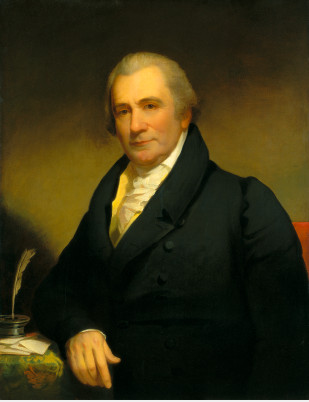
Robert Coleman was an American industrialist and politician who became Pennsylvania's first millionaire.

Saint Peters is an historic, nineteenth-century, industrial, company village that is located in Chester County, Pennsylvania, United States. Built near the Falls of French Creek in Warwick Township, it is situated in the Hopewell Big Woods.

The Stiegel-Coleman House, also known as Elizabeth Furnace, is an historic mansion house which is located at 2121 Furnace Hills Pike, just north of Brickerville, Pennsylvania.
Peter Grubb (c.1702—1754), the founder of the Grubb Family Iron Dynasty, discovered Cornwall Iron Mines and established Cornwall Iron Furnace, together one of the largest ironworks in Colonial Pennsylvania. The Cornwall Iron Mines are the largest U.S. iron mines ever discovered east of Lake Superior.

John Grubb (1652–1708) was a two-term member of the Pennsylvania Provincial Assembly and was one of the original settlers in a portion of Brandywine Hundred that became Claymont, Delaware. He founded a large tannery that continued in operation for over 100 years at what became known as Grubb's Landing. He was also one of the 150 signers of the Concessions and Agreements for Province of West Jersey.

Mount Hope Estate is a National Register of Historic Places-listed property in Rapho and Penn Townships, Lancaster County, Pennsylvania. The original estate was the center of operations of the Grubb Family Iron Dynasty during the 19th century and included over 2,500 acres (1,000 ha), a charcoal iron furnace, a grist mill, housing for employees and tenants, plus supporting structures such as a post office, a general store, a railroad station, a school and a church. The existing mansion and grounds remain from what was once a thriving industrial headquarters complex and small village.
Curtis Grubb (c.1730—1789), Patriot and oldest son of Peter and Martha Bates Grubb, was a second-generation member of the Grubb Family Iron Dynasty along with his younger brother Peter Jr. The brothers operated the Cornwall Ironworks, making significant contributions to the American Revolutionary War effort, and Curtis served several terms in the Pennsylvania Provincial Assembly. He was also one of the largest enslavers in Pennsylvania at the time of independence, registering twenty-five people as his property in 1780 in accordance with state gradual abolition law.
Peter Grubb Jr. (1740–1786), Patriot and second son of Peter and Martha Bates Grubb, was a second-generation member of the Grubb Family Iron Dynasty along with his older brother Curtis Grubb. They operated the Cornwall Ironworks, making significant contributions to the American Revolutionary War effort.
Jehu Grubb, unacknowledged son of the prominent ironmaster Curtis Grubb, was an early settler who became a leading citizen in Plain Township, Stark County, Ohio. Grubb served in the War of 1812, was a justice of the peace, served in the Ohio House of Representatives in 1828 and 1832, and in 1852 donated land for the Whitehall School. Grubb was often called John in various documents, and seems to have used both names himself. His stepson built the beautiful and historic Jacob H. Bair House on what been a corner of Grubb's farm.
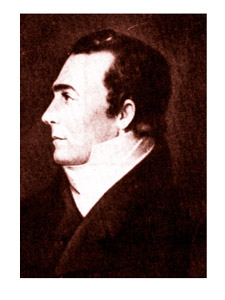
Henry Bates Grubb was a third-generation member of the Grubb Family Iron Dynasty, the founder of the family's enterprises headquartered at Mount Hope near Lancaster, Pennsylvania, and perhaps the family's first "true" ironmaster. He was the son and heir of Peter Grubb, Jr. who, with his brother Curtis, had owned and operated the Cornwall ironworks founded by their father Peter Grubb in 1737. Henry and his heirs rebuilt the family business after most of the original Peter Grubb holdings were gradually acquired by Robert Coleman between 1783 and 1802. The Grubbs and Colemans were among the largest iron producers in Pennsylvania through the mid-19th century.
The Grubb Family Iron Dynasty was a succession of iron manufacturing enterprises owned and operated by Grubb family members for more than 165 years. Collectively, they were Pennsylvania's leading iron manufacturer between 1840 and 1870.

The Joanna Furnace Complex was an iron furnace that operated from 1792 to 1901 in Robeson Township, Berks County, Pennsylvania. It was founded by Samuel Potts and Thomas Rutter III and named for Potts's wife Joanna.










